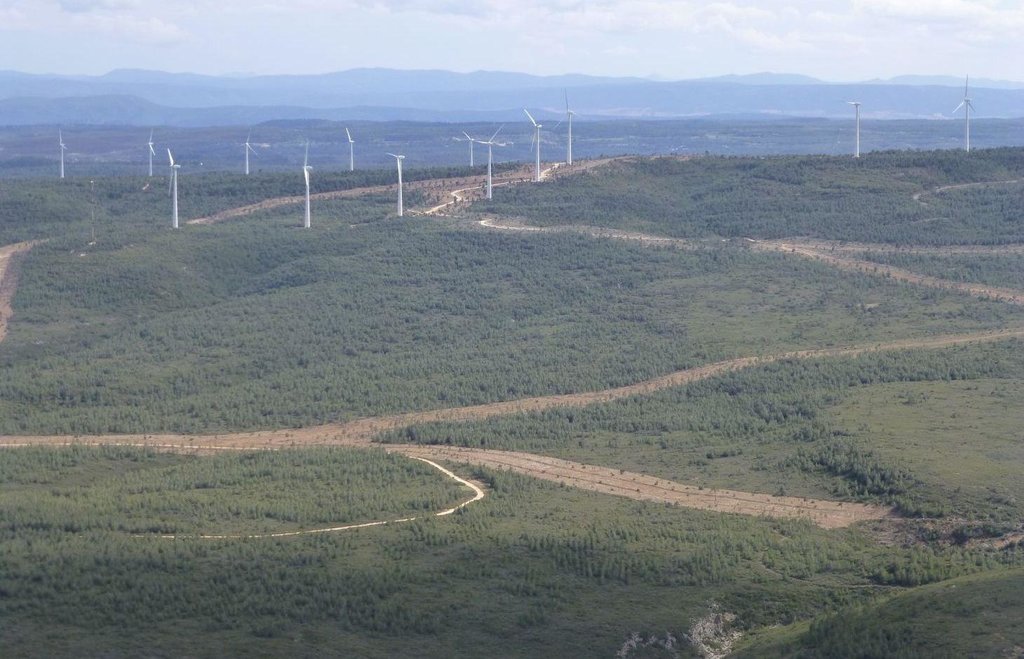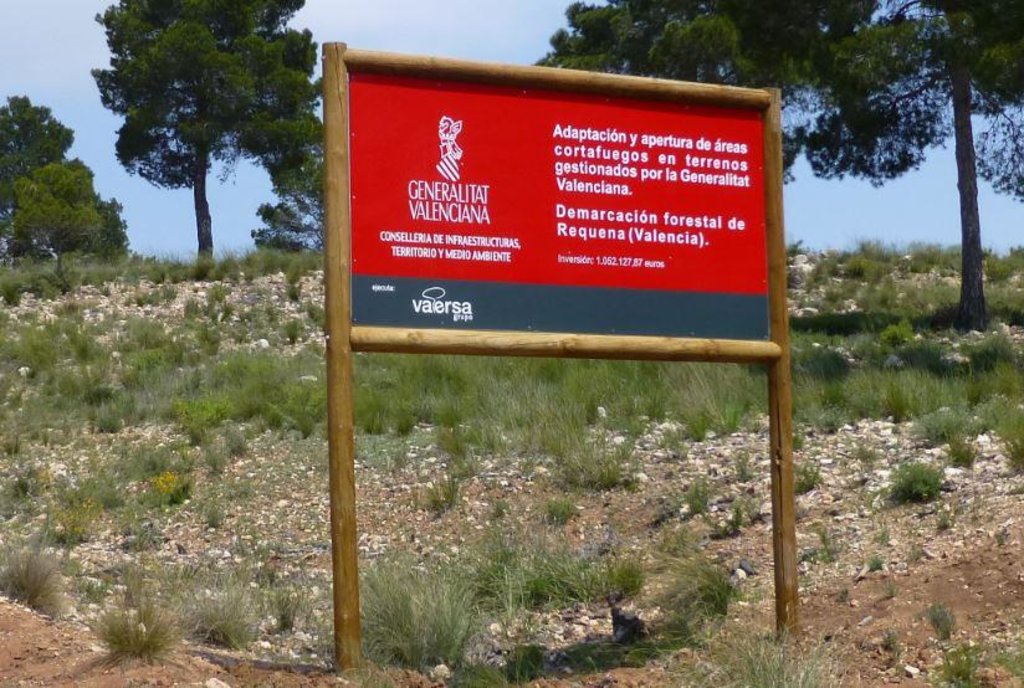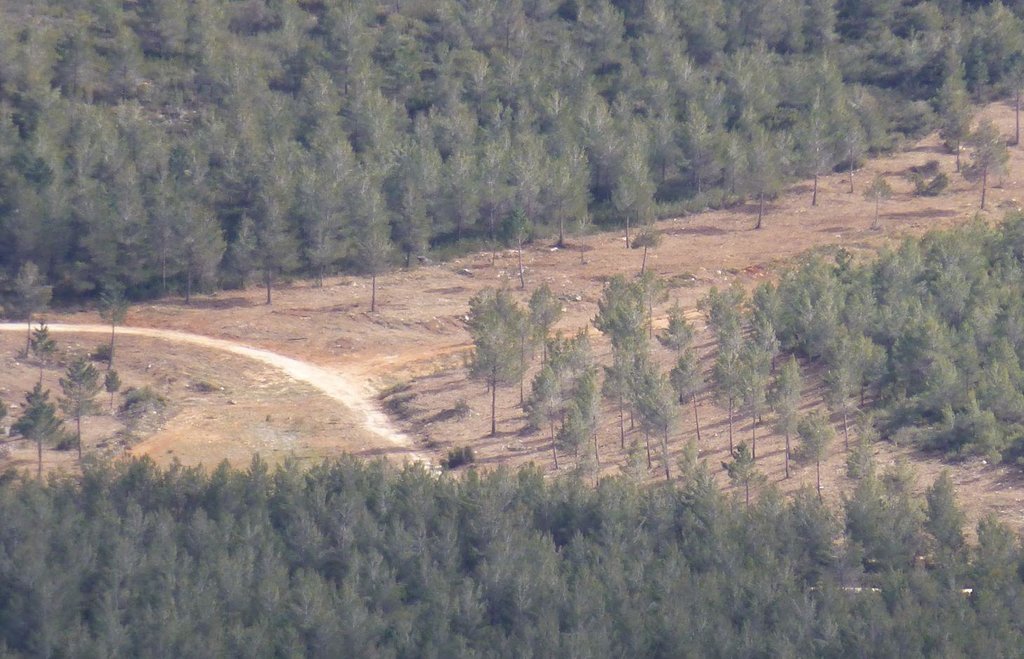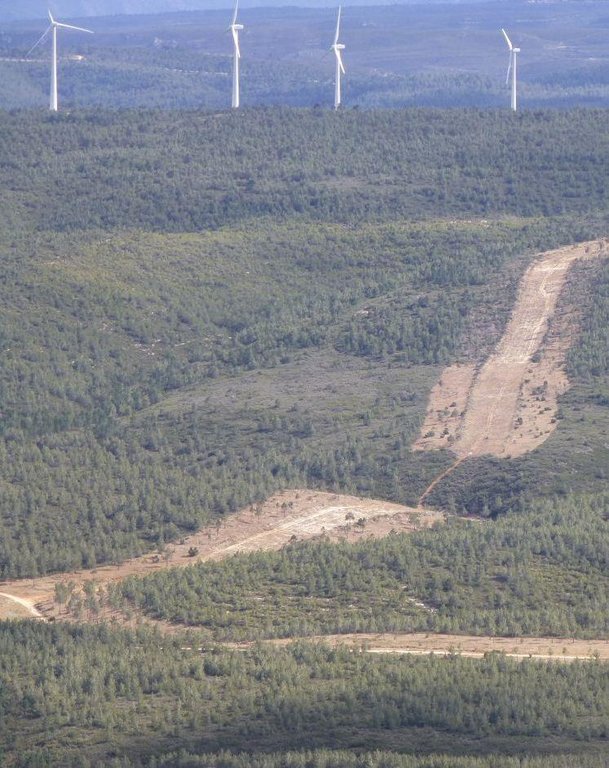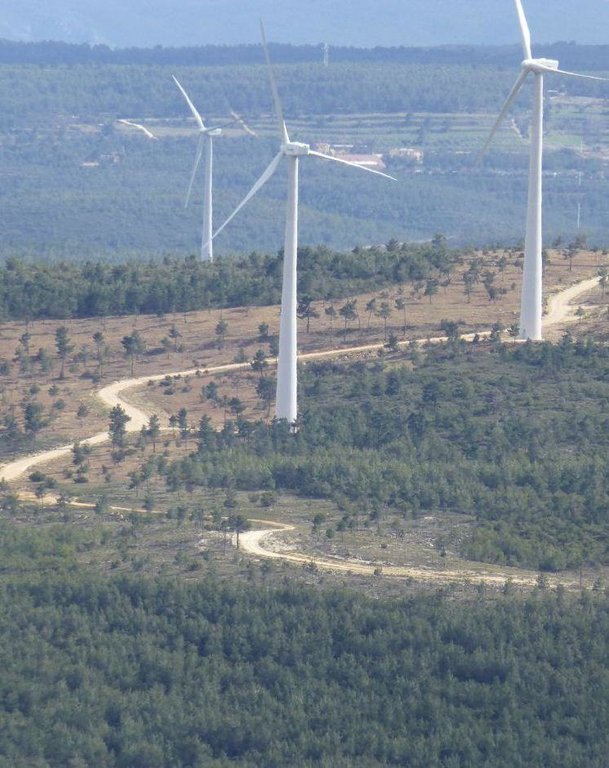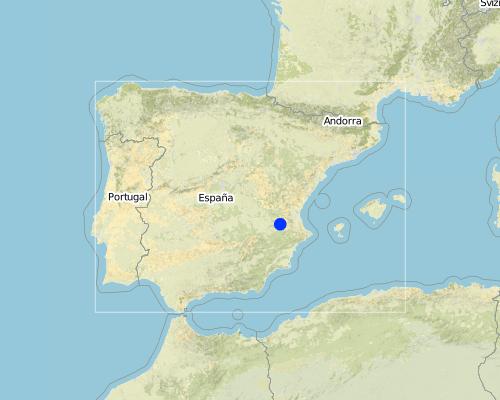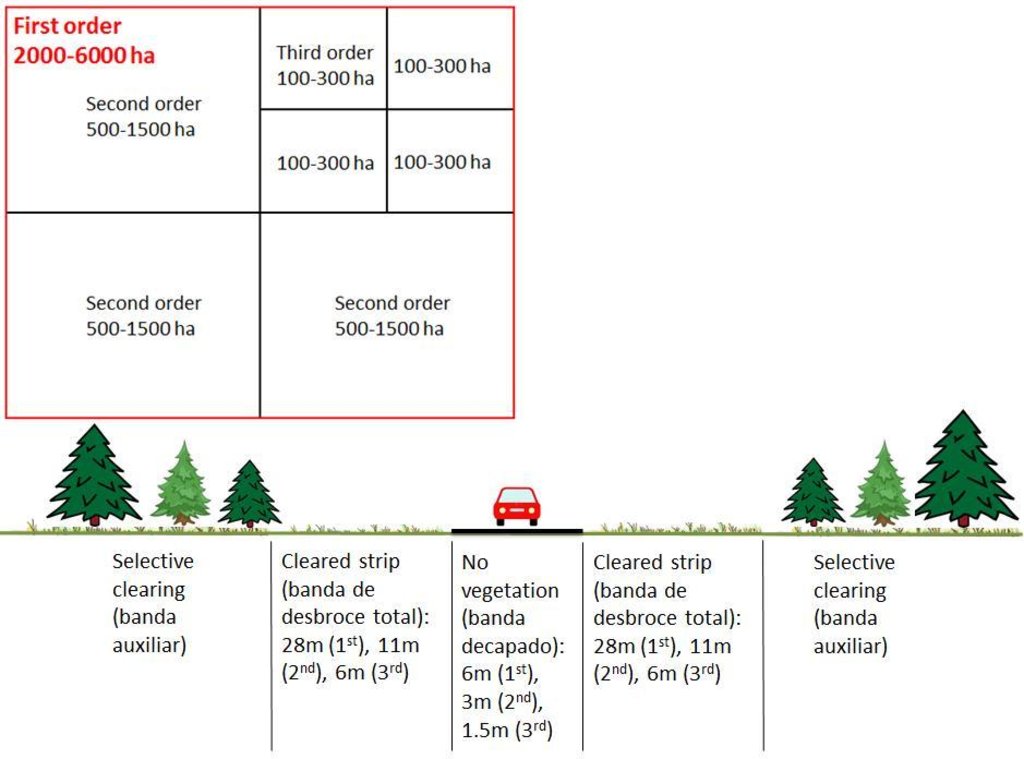Cleared strip network for fire prevention (firebreaks) [Испани]
- Шинийг нээх:
- Шинэчлэх:
- Эмхэтгэгч: Nina Lauterburg
- Хянан тохиолдуулагч: –
- Хянагчид: Deborah Niggli, Nina Lauterburg
Área cortafuegos
technologies_1592 - Испани
- Бүрэн хураангуйн PDF хувилбар
- Бүрэн хураангуйг PDF-ээр хэвлэх
- Хөтөч дэх бүрэн хураангуй
- Бүрэн хураангуй (форматгүй)
- Cleared strip network for fire prevention (firebreaks): 03 1-р сар 2017 (inactive)
- Cleared strip network for fire prevention (firebreaks): 15 3-р сар 2017 (inactive)
- Cleared strip network for fire prevention (firebreaks): 31 7-р сар 2019 (inactive)
- Cleared strip network for fire prevention (firebreaks): 01 12-р сар 2021 (public)
Бүлгүүдийг үзэх
Бүгдийг дэлгэх Бүгдийг хаах1. Ерөнхий мэдээлэл
1.2 Технологийг үнэлэх, баримтжуулах ажилд хамаарах мэдээлэл өгсөн хүмүүс, байгууллагуудын холбоо барих мэдээлэл
Технологи баримтжуулах/үнэлэх ажилд дэмжлэг үзүүлсэн төслийн нэр (шаардлагатай бол)
Catastrophic shifts in drylands (EU-CASCADE)Технологи баримтжуулах/үнэлэх ажилд дэмжлэг үзүүлсэн байгууллага(ууд)-ын нэр (шаардлагатай бол)
Centro de Estudios Ambientales del Mediterraneo (CEAM) - Испани1.3 ВОКАТ-аар баримтжуулсан өгөгдлийг ашиглахтай холбоотой нөхцөл
Мэдээллийг хэзээ (газар дээр нь) цуглуулсан бэ?
06/05/2013
Эмхэтгэгч болон гол мэдээлэгч хүн(хүмүүс) WOCAT аргачлалаар баримтжуулсан мэдээллийг ашиглахтай холбоотой нөхцлийг хүлээн зөвшөөрсөн:
Тийм
1.4 Технологи тогтвортой гэдгийг баталгаажуулах
Энэ технологийг газрын доройтлыг бууруулж, газрын тогтвортой менежментийг хангахад тохиромжтой гэж үзэж болох уу?
Үгүй
1.5 ГТМ-ийн Арга барилын талаархи санал асуулгын(д) суурь мэдээлэл
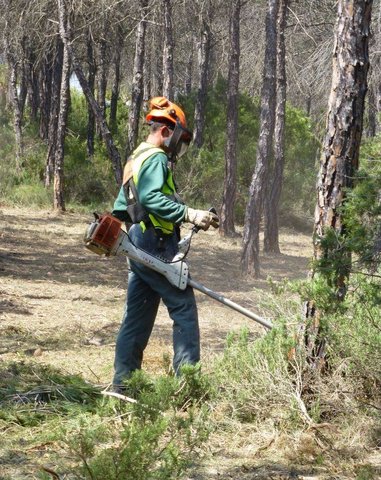
Plan of preventive silviculture (PSP): implementation of firebreak … [Испани]
Through the declaration of Ayora to a forest intervention area (ZAU) and the implementation of the pilot project of the PSP, a preventive silviculture was promoted through the establishment of a firebreak network.
- Эмхэтгэгч: Nina Lauterburg
2. ГТМ Технологийн тодорхойлолт
2.1 Технологийн товч тодорхойлолт
Технологийн тодорхойлолт:
The basic principle of a firebreak network is to split continuous forest areas (where a lot of fuel is built up) into smaller patches separated by vegetation-free strips in order to prevent large forest fires.
2.2 Технологийн дэлгэрэнгүй тодорхойлолт
Тодорхойлолт:
In the forest law 3/1993 the declaration of special areas to “Zonas de Actuación Urgente (ZAU)” (zone of urgent actions) through the regional government of Valencia is defined. Objectives are the protection against natural hazards and the promotion of forest restoration within this area. Ayora was declared to a ZAU in 1997 due to its high risk of fires. In the “Plan de Selvicultura Preventiva de Incendios en los Sistemas Forestales de la Comunidad Valenciana” which became operative in 1996 and whose main objective is the reduction of the fire risk, the ZAU is practically addressed for the first time in the establishment of firebreaks (áreas cortafuegos). Based on this plan, the firebreaks were established within a pilot project “Proyecto Piloto de Selvicultura Preventiva” between 1998 and 2002, carried out by the company VAERSA (public company of the Generalitat Valenciana).
A firebreak is a strategically located strip on which the vegetation cover has been partially or totally removed down to mineral soil with the aim of controlling the spread of large forest fires. The main purposes are 1) to interrupt the continuity of hazardous fuels across a landscape to decrease the area affected by fires, 2) to provide areas where fire fighters are protected and can work more efficiently, 3) to slow down a fire, to reduce the fire intensity and caused damages, and 4) to provide strips where fuel management is facilitated. The total surface protected by the firebreaks is 33’851 ha while the management measures are executed on 1944,81 ha. This technology is also applied in other countries, e.g. Portugal, South Carolina or South Africa.
The establishment and maintenance are labour-intensive and expensive. Firebreaks can range between a protected area of 2000-6000 ha (first order), 500-1500 ha (second order), and 100-300 ha (third order), together forming a system isolating separate areas by wide strips. This parcelling aims in limiting the burnt area to a maximum of 6000 ha. Each firebreak consists of a bare vegetation-free strip (banda decapado). The width of the bare area ranges between 6m (first order), 3m (second order) and 1.5m (third order). Existing vegetation-free areas (e.g. roads) are used to establish firebreaks to have less visual impact. If there is no road, trees and shrubs have to be cleared and chipped entirely using chainsaws and special tractors. On each side of the bare area there is a totally cleared strip (banda de desbroce total). The width depends on the climatic zone, the order and the hazard of fuel, therefore ranging between 28m (first order), 11m (second order) and 6m (third order). Almost all the existing vegetation is cleared, only some isolated mature trees are not cut if they do not contribute to the propagation of a fire. On both sides of these strips there are auxiliary strips (banda auxiliar) where selective clearing is applied until reaching a desired density. Sick trees are cleared with priority. Species of high ecologic value and low flammability level are not cleared, such as Juniperus phoenicea, Juniperus oxycedrus and Quercus ilex ssp. rotundifolia. The width of these elements can vary according to the prevalent conditions. A part of the wood generated by the clearings is used as fuelwood, the other part is chipped and distributed on the soil as mulch. Firebreaks are often located on mountain ridges and created with 45° to the dominant wind direction (west) to facilitate fire extinction.
The maintenance of firebreaks is extremely important. Without clearing, fire-prone species will encroach which decreases the effectiveness of the firebreak. The maintenance is realized depending on the vegetation, usually in firebreaks of first order the maintenance is done every 2 years (“decapado” and “desbroce total”) or every 4 years (“banda auxiliar”) while firebreaks of second and third order are cleared every 4 years. In the here described project the maintenance was carried out in three phases (2001-2004, 2004-2008 and 2008-2012).
The region of Ayora is mountainous with a dry subhumid climate (~380 mm annual rainfall). The risk of fire incidence is at its highest from June to September when there are adverse conditions like drought, high temperatures and strong winds (mainly the winds coming from central Spain, called “poniente”). The population density is very low and there are only few job opportunities (e.g. marginal agriculture, grazing, hunting, beekeeping, artisanry, wind mill parc). Most of the inhabitants work in the nuclear power plant. Forest management could be a source for jobs.
2.3 Технологийн гэрэл зураг
2.5 Энэ үнэлгээнд хамрагдсан технологийг хэрэгжүүлсэн улс орон/ бүс нутаг/ байршил
Улс:
Испани
Улс/аймаг/сум:
Spain, Valencia
Байршлын дэлгэрэнгүй тодорхойлолт:
Region of Ayora (including the municipalities Requena, Cofrentes, Jalance, Jarafuel, Zarra, Ayora)
Тайлбар:
Boundary points of the Technology area: The above indicated coordinates only show one firebreak (first order). But there is a whole system of firebreaks which is visible in the Google Earth file.
Map
×2.6 Хэрэгжсэн хугацаа
Байгуулсан тодорхой оныг мэдэхгүй бол баримжаа хугацааг тодорхойл:
- 10-50 жилийн өмнө
2.7 Технологийн танилцуулга
Технологийг хэрхэн нэвтрүүлснийг тодорхойл:
- Гадны төсөл/хөтөлбөрийн дэмжлэгтэйгээр
Тайлбар (төслийн төрөл г.м.):
In the past, farmers built small firebreaks on their own. When the forest law (ley forestal 3/1993) became effective in the year 1993 the construction of big firebreaks became mandatory. The firebreaks which are documented here were established within a pilot project carried out in the ZAU Ayora (zona de actuación urgente, zone of urgent actions) between 1998 and 2002.
3. ГТМ технологийн ангилал
3.1 Технологийн үндсэн зорилго (ууд)
- гамшгийн эрсдлийг бууруулах
3.2 Технологи нэвтрүүлсэн газрын одоогийн газар ашиглалтын хэлбэр(үүд)

Байгалийн ой / модтой газар
(Таримал) байгалийн ой/мод бүхий газар:
- Сонгомол огтлол
- Нэлэнхүй огтлол
Бүтээгдэхүүн ба үйлчилгээ:
- Мод бэлтгэл
- Түлшний мод
- Жимс, самар
- Ойн бусад дагалт бүтээгдэхүүн
- Бэлчээрийн талбай/Хариулгатай бэлчээрлэлт
- Байгалийн нөөцийг хамгаалах
- Амралт/ аялал жуулчлал
- Байгалийн гамшигаас сэргийлэх
- wind mill parc, hunting
Тайлбар:
Major land use problems (compiler’s opinion): In Ayora, the prevalent dense shrublands (dominated by seeder species), which resulted from past agricultural land use (changes of the vegetation composition, e.g. removal of key species), land abandonment/rural depopulation and fire occurrence, contain a high fire risk because of both the high fuel loads and their continuity. Also dense forests (either afforestations or natural regeneration) show a high risk for fires. Through the modifications of the vegetation composition in the past (removal of more fire resistant resprouter species (mature forest), whereas fire-prone seeder species are now spreading), the resilience of the ecosystem to fires has decreased. Today a higher fire recurrence can be observed which could still be worsen by future climate change impacts, undermining more and more the ecosystem’s capacity to buffer such shocks. Before the implementation of firebreaks, it was almost impossible to stop a fire and it was much more dangerous for fire fighters. There was also no access for fire-fighting vehicles.
Selective felling of (semi-) natural forests: As a management practice. The forest should be cleared more frequently since there is a huge amount of fuel.
Clear felling of (semi-)natural forests: Within the firebreak
Plantation forestry: Almost the whole forest in this region was planted
3.3 Газар ашиглалтын тухай нэмэлт мэдээлэл
Жилд ургамал ургах улирлын тоо:
- 1
3.4 Технологи ГТМ-ийн аль бүлэгт хамаарах вэ
- Байгалийн ба сайжруулсан ойн менежмент
3.5 Технологийн хамрах талбай
Технологи өргөн дэлгэрсэн эсхийг тодорхойл:
- газар дээр жигд тархсан
Технологи газар нутгийн хэмжээнд жигд тархсан бол түүний эзлэх талбайг дундажаар тооцож тэмдэглэ:
- 100-1,000 км2
Тайлбар:
Total area covered by the SLM Technology is 338.5 m2.
The total surface protected by the firebreaks within the pilot project is 33’851 ha (including the municipalities Requena, Cofrentes, Jalance, Jarafuel, Zarra, Ayora). The management measures are executed on a surface of 1944,81 ha and the total length of the elements is 475,06 km.
3.6 Технологийг бүрдүүлэх ГТМ арга хэмжээ

Ургамлын арга хэмжээ
- V3: Ургамлан нөмрөгийг хөндөх
3.7 Технологид харгалзах газрын доройтлын төрөл

биологийн доройтол
- Bc: Ургамлан нөмрөг багасах
- Bf: түймрийн хорт үр дагавар
Тайлбар:
Main causes of degradation: deforestation / removal of natural vegetation (incl. forest fires) (Deforestation in the past (removal of resprouter species), land abandonment, uncontrolled growth of fire prone vegetation, afforestations, forest fires), population pressure (Vast areas were deforested in the past for agriculture, important key species were removed. After land abandonment there was a lack of management strategies), poverty / wealth (The current economic crisis in Spain leads to a lack of investment in forest management, therefore only a minor part of forests is managed (natural parks)), labour availability (In the past there was outmigration from the region to the big cities and therefore there was a lack of management)
Secondary causes of degradation: change of seasonal rainfall (More variability in precipitation leads to a higher risk of fires), droughts (more fires during droughts), land tenure (The state is only allowed to apply management practices in public forest. The private forest is often not managed which increases the risk of fires and the resulting degradation), inputs and infrastructure: (roads, markets, distribution of water points, other, …) (There were big fires in the past because of the lack of fire extinction media like water ponds, streets, transport media (this has been improved now)), education, access to knowledge and support services (Loss of knowledge, important for today’s fires: People (especially from the cities) are not aware anymore of the risk of fire. In the past people lived with the risk and knew how to prevent fires), governance / institutional (Law to induce implementation of conservation interventions (ley forestal 3/1993) and “plan de selvicultura preventiva de incendios en los sistemas forestales de Valencia (1996)”. Before less practices)
3.8 Газрын доройтлоос урьдчилан сэргийлэх, сааруулах ба нөхөн сэргээх
Газрын доройтолтой холбоотойгоор Технологи ямар зорилго тавьсан болохыг тодорхойл:
- газрын доройтлоос урьдчилан сэргийлэх
4. Техникийн нөхцөл, хэрэгжүүлсэн үйл ажиллагаа, материал ба зардал
4.1 Технологийн техник зураг
4.2 Техникийн үзүүлэлт/ техникийн зургийн тайлбар
Firebreaks can range between a protected area of 2000-6000 ha (first order), 500-1500 ha (second order), and 100-300 ha (third order), together forming a system isolating separate areas by wide strips. This parcelling aims in limiting the burnt area to a maximum of 6000 ha. Each firebreak consists of a bare strip (banda decapado) ranging between 6m (first order), 3m (second order) and 1.5m (third order). On both sides of the bare area there is a totally cleared strip (banda de desbroce total) whose width ranges between 28m (first order), 11m (second order) and 6m (third order). On both sides of these strips there are auxiliary strips (banda auxiliar) where selective clearing is applied. The width of these elements can vary according to the prevalent conditions.
Location: Ayora. Valencia, Spain
Date: 02-12-2013
Technical knowledge required for field staff / advisors: high (The forest agent needs a high technical knowledge. He acts as a link between engineer and forest brigade and controls if the brigade executes what the engineer dictates. He also provides assistance.)
Technical knowledge required for Engineer: high (The forest engineer works for the state and plans where to establish fire breaks and how to construct them (e.g. how much fuel to remove, which machines to use). He needs a high technical knowledge.)
Technical knowledge required for Forest brigade/workers: low (The forest workers only execute what the engineer and the forest agent tell them. They need to know how to handle the machines but don’t have to judge where and how to establish the firebreaks.)
Main technical functions: control of fires
Secondary technical functions: reduction of dry material (fuel for wildfires)
Vegetative measure: Clearing to establish strips free of vegetation
Vegetative material: T : trees / shrubs
Trees/ shrubs species: Trees and shrubs are cleared
4.3 Материал болон зардалд хамаарах ерөнхий мэдээлэл
бусад/үндэсний мөнгөн нэгж (тодорхойл):
Euro
Ам.доллар ба үндэсний мөнгөн нэгж хоорондын хөрвөх үнийг тодорхойл (шаардлагатай бол): 1 USD =:
0.74
Хөлсний ажилчны нэг өдрийн цалингийн хэмжээг тодорхойлно уу:
47.00
4.4 Бий болгох үйл ажиллагаа
| Үйл ажиллагаа | Арга хэмжээний төрөл | Хугацаа | |
|---|---|---|---|
| 1. | Project planning and design of firebreak system | Ургамлын | 1996 |
| 2. | Adaption of the agricultural tractors with forest management machinery (wheels, protection of the machine against stones, clearing machinery with chains) | Ургамлын | 1998-2002 |
| 3. | Cutting and chipping (in-situ) of trees and shrubs (execution of firebreak network) | Ургамлын | 1998-2002 |
| 4. | Transport of wood (fuel wood) | Ургамлын | 1998-2002 |
4.5 Бий болгоход шаардагдсан зардал, хөрөнгийн өртөг
| Зардлын нэр, төрөл | Хэмжих нэгж | Тоо хэмжээ | Нэгжийн үнэ | Зардал бүрийн нийт өртөг | Нийт дүнгээс газар ашиглагчийн төлсөн % | |
|---|---|---|---|---|---|---|
| Хөдөлмөр эрхлэлт | labour | ha | 1.0 | 1095.0 | 1095.0 | |
| Тоног төхөөрөмж | machine use | ha | 1.0 | 675.0 | 675.0 | |
| Технологи бий болгох нийт үнэ өртөг | 1770.0 | |||||
Тайлбар:
Duration of establishment phase: 36 month(s)
4.6 Арчилгаа/ урсгал үйл ажиллагаа
| Үйл ажиллагаа | Арга хэмжээний төрөл | Хугацаа/ давтамж | |
|---|---|---|---|
| 1. | Clearing of firebreaks of first order (every 2 years) | Ургамлын | every 2 years |
| 2. | Clearing of firebreaks of second and third order (every 4 years) | Ургамлын | every 4 years |
4.7 Арчилгаа/урсгал ажилд шаардагдсан зардал, хөрөнгийн өртөг (нэг жилд)
| Зардлын нэр, төрөл | Хэмжих нэгж | Тоо хэмжээ | Нэгжийн үнэ | Зардал бүрийн нийт өртөг | Нийт дүнгээс газар ашиглагчийн төлсөн % | |
|---|---|---|---|---|---|---|
| Тоног төхөөрөмж | machine use | ha | 1.0 | 557.0 | 557.0 | |
| Технологийн арчилгаа/урсгал үйл ажиллагаанд шаардагдах нийт үнэ өртөг | 557.0 | |||||
Тайлбар:
The total costs of the firebreaks (establishment and maintenance) were calculated for the application of the technology on one hectare, based on the indications given in the official project documents of the regional government (Generalitat Valenciana) and information from different stakeholders (e.g. forest agent, university staff, employee of VAERSA). The whole project costs were around 3 Mio Euro for the establishment and around 1.5 Mio Euro for the maintenance phase. The maintenance costs refer to the third maintenance phase taking place from 2008 to 2012. The costs of the execution of the project were 1312 Euro/ha (1770 Dollar) and the costs of the maintenance were 82.03 Euro/ha (110 Dollar, after 2 years) and 331.37 Euro/ha (446 Dollar, after 4 years).
The currency rate (Euro-Dollar) was calculated on November 16th, 2013.
4.8 Зардалд нөлөөлж байгаа хамгийн чухал хүчин зүйл
Өртөг, зардалд нөлөөлөх гол хүчин зүйл:
The costs of the establishment of firebreaks can be affected by numerous factors, such as slope (if the slope is steep, the work is much more difficult and takes more time, because machines cannot be used on steep slopes), vegetation density (it takes more time to clear a dense area), stone content of the soil (if there are many stones the work is much more difficult for the machines and more dangerous for the workers), availability of a road (where a firebreak can be established, costs can be saved). Important to note is that maintenance costs could increase with an increase in rainfall because the vegetation will grow faster (otherwise firebreaks are quite resistant against climate change or weather extremes). Furthermore, modifying a normal tractor for forest management can be extremely expensive.
5. Байгаль ба нийгмийн нөхцөл
5.1 Уур амьсгал
Жилийн нийлбэр хур тундас
- < 250 мм
- 251-500 мм
- 501-750 мм
- 751-1,000 мм
- 1,001-1,500 мм
- 1,501-2,000 мм
- 2,001-3,000 мм
- 3,001-4,000 мм
- > 4,000 мм
Хур тунадасны талаархи тодорхойлолт/ тайлбар:
Ayora (383mm)
Агро-уур амьсгалын бүс
- чийглэг
Thermal climate class: temperate
5.2 Гадаргын хэлбэр
Дундаж налуу:
- хавтгай (0-2 %)
- бага зэрэг налуу (3-5 %)
- дунд зэрэг налуу (6-10 % )
- хэвгий (11-15 %)
- налуу (16-30 %)
- их налуу (31-60 % )
- эгц налуу (>60 %)
Гадаргын хэлбэр:
- тэгш өндөрлөг / тал
- нуруу
- уулын энгэр
- дов толгод
- бэл
- хөндий
Өндрийн бүслүүр:
- 0-100 д.т.д. м.
- 101-500 д.т.д. м.
- 501-1,000 д.т.д м.
- 1,001-1,500 д.т.д м.
- 1,501-2,000 д.т.д м.
- 2,001-2,500 д.т.д. м.
- 2,501-3,000 д.т.д. м.
- 3,001-4,000 д.т.д м.
- > 4,000 д.т.д. м.
5.3 Хөрс
Хөрсний дундаж зузаан:
- маш нимгэн (0-20 см)
- нимгэн (21-50 см)
- дунд зэрэг зузаан (51-80 см)
- зузаан (81-120 cм)
- маш зузаан (>120 cм)
Хөрсний бүтэц (өнгөн хөрс):
- нарийн /хүнд (шаварлаг)
Өнгөн хөрсөнд агуулагдах ялзмаг:
- бага (<1 % )
5.4 Усны хүртээмж ба чанар
Гүний усны түвшин:
5-50 м
Гадаргын усны хүртээмж:
хангалтгүй/ байхгүй
Усны чанар (цэвэршүүлээгүй):
сайн чанарын ундны ус
5.5 Биологийн олон янз байдал
Зүйлийн олон янз байдал:
- дунд зэрэг
5.6 Технологи нэвтрүүлсэн газар ашиглагчдын тухай мэдээлэл
Үйлдвэрлэлийн системийн зах зээлийн чиг баримжаа:
- холимог (амь зуух/ худалдаа наймаа
Хувь хүн эсвэл бүлэг:
- ажилтан (компани, засгийн газар)
Хүйс:
- эрэгтэй
Газар ашиглагчдын бусад шинж чанарыг тодорхойл:
Land users applying the Technology are mainly common / average land users
Difference in the involvement of women and men: The work is mainly done by men, because it is heavy work and it is not usual that women are working in the forest.
Population density: < 10 persons/km2
Annual population growth: negative
Off-farm income specification: The forest brigade is only working when there is money and a project. If there is no money they have no work and need to have a look for another job.
5.8 Газар эзэмшил, газар ашиглах эрх, ус ашиглах эрх
Газар өмчлөл:
- төрийн
- хувь хүн, өмчийн гэрчилгээтэй
Газар ашиглах эрх:
- хувь хүн
- open access but organised (e.g. wood, hunting)
- open access but organised (e.g. wood, hunting)
Тайлбар:
There is some public land, controlled by the state. But there is also some private land. The access to the public land is open but organized. Permission is needed from the government to cut trees, to build a house or to hunt. There are some private hunting areas for which the hunting association has to pay a fee.
6. Үр нөлөө ба дүгнэлт
6.1 Технологийн талбайд үзүүлсэн нөлөө
Нийгэм-эдийн засгийн үр нөлөө
Үйлдвэрлэл
тэжээл үйлдвэрлэл
Тайлбар/ тодорхой дурьдах:
Vegetation removal produces fresh growth. More grasses available for animals (game and livestock) in the cleared areas.
тэжээлийн чанар
Тайлбар/ тодорхой дурьдах:
The new growth provides more diverse and nutritious fodder. Animals (especially goats) eat everything but they like more young grasses than shrubs
малын бүтээмж
Тайлбар/ тодорхой дурьдах:
Game/wildlife and livestock are better because there is an increase in fodder quantity and quality
модлогийн бүтээмж
Тайлбар/ тодорхой дурьдах:
The wood/timber generated by the clearing can be used for biomass, fertilizers, pellets, firewood. A part of the wood is chipped in-situ and applied as mulch
үйлдвэрлэлийн газар
Тайлбар/ тодорхой дурьдах:
In some areas, the implementation of firebreaks can occupy productive land which means a loss of land. The main objective of this technology is to provide protection from forest fires instead of creating productive land
эрчим хүчний үйлдвэрлэл
Тайлбар/ тодорхой дурьдах:
In some areas, the cleared ground on mountain ridges is used for wind mills. A part of the cleared vegetation is used for bioenergy (biomass).
Орлого, зарлага
ХАА-н зардал
Тайлбар/ тодорхой дурьдах:
The establishment and the maintenance of fire breaks is expensive.
Нийгэм-эдийн засгийн бусад үр нөлөө
fuelwood
Тайлбар/ тодорхой дурьдах:
Villagers of Jarafuel receive fuelwood gained by clearings for free (from municipal council).
job uncertainty
Тайлбар/ тодорхой дурьдах:
If there is no money provided by the state the maintenance of fire breaks cannot be executed. This constitutes a high risk for forest workers because they never know if they will loose their job.
Нийгэм-соёлын үр нөлөө
хүнсний аюулгүй байдал/ өөрийн хэрэгцээг хангах
Тайлбар/ тодорхой дурьдах:
Forest workers earn money to buy food, otherwise they would depend on unemployment pay and thus put pressure on the state.
эрүүл мэндийн байдал
Тайлбар/ тодорхой дурьдах:
Improved air quality by reducing forest fires.
амралт, рекреацийн боломжууд
Тайлбар/ тодорхой дурьдах:
People often criticise the aesthetic impact of fire breaks. But this impact is smaller than if the whole forest is burnt
ГТМ/ газрын доройтлын мэдлэг
Тайлбар/ тодорхой дурьдах:
Local people know about the importance of conservation of the area and really like to have the forest protected of wildfires
маргааныг шийдвэрлэх
Тайлбар/ тодорхой дурьдах:
Less fires result in a decrease of the destroyed area, less money will have to be invested in restoration or fire extinction. Farmers, hunters,honey producers will experience fewer losses. Wild animals remain in the forest (more grasses after clearing).
нийгэм, эдийн засгийн хувьд эмзэг бүлгийнхний нөхцөл байдал
Тайлбар/ тодорхой дурьдах:
More jobs for unemployed, this is especially important during the current economic crisis
contribution to human well-being
Тайлбар/ тодорхой дурьдах:
Through the establishment and the maintenance of firebreaks it is easier to control fires and protect people. Furthermore it created jobs for the unemployed. But it seems that in general forest management is not something people want to do, they work in this sector only if there are no other job opportunities. Forest management means a hard job and this kind of work is not well-respected in society
Экологийн үр нөлөө
Усны эргэлт/ илүүдэл
гадаргын урсац
Тайлбар/ тодорхой дурьдах:
On the cleared strips, associated with the vegetation removal
Хөрс
хөрсний чийг
Тайлбар/ тодорхой дурьдах:
On the cleared strips, associated with the vegetation removal
хөрсөн бүрхэвч
Тайлбар/ тодорхой дурьдах:
On the cleared strips, but not too bad because of the mulch layer (removed vegetation is chipped in-situ)
хөрсний органик нэгдэл/ хөрсөнд агуулагдах карбон
Тайлбар/ тодорхой дурьдах:
On the cleared strips, associated with the vegetation removal
Уур амьсгал болон гамшгийн эрсдлийг бууруулах
нүүрстөрөгч ба хүлэмжийн хийн ялгаруулалт
Тайлбар/ тодорхой дурьдах:
If the fire is stopped more quickly there will be less emissions
түймрийн эрсдэл
Тайлбар/ тодорхой дурьдах:
The firebreaks prevent the occurrence and spread of large forest fires by providing access for fire fighters
6.2 Технологийн талбайн гадна үзүүлсэн үр нөлөө
голын адагт үерлэх
Тайлбар/ тодорхой дурьдах:
When fire removes less vegetation then the soil is less prone to flooding
голын адагт лаг шавар хуримтлагдах
Тайлбар/ тодорхой дурьдах:
When fire removes less vegetation then the soil is less vulnerable to erosion
хөрш зэргэлдээ газарт учирах хохирол
нийтийн/хувийн хэвшлийн дэд бүтцэд учрах хохирол
Тайлбар/ тодорхой дурьдах:
Forest fire frequency and intensity and the associated damages are reduced
6.3 Технологийн уур амьсгалын өөрчлөлт, цаг агаарын гамшигт үзэгдэлд өртөх байдал ба эмзэг байдал (газар ашиглагчийн бодлоор)
Уур амьсгалын аажим өөрчлөлт
Уур амьсгалын аажим өөрчлөлт
| Улирал | Уур амьсгалын өөрчлөлт/экстрим үзэгдлийн төрөл | Технологи түүний нөлөөг хэрхэн бууруулж байна? | |
|---|---|---|---|
| жилийн дундаж температур | Өсөлт | сайн |
Уур амьсгалаас хамаарах аюул (гамшиг)
Цаг уурын гамшигт үзэгдэл
| Технологи түүний нөлөөг хэрхэн бууруулж байна? | |
|---|---|
| орон нутгийн аадар бороо | сайн |
| орон нутгийн салхин шуурга | муу |
Уур амьсгалын гамшиг
| Технологи түүний нөлөөг хэрхэн бууруулж байна? | |
|---|---|
| ган гачиг | муу |
Усзүйн гамшиг
| Технологи түүний нөлөөг хэрхэн бууруулж байна? | |
|---|---|
| усны үер (гол) | сайн |
Тайлбар:
The technology was not modified. The firebreaks are quite resistant against climate change or weather extremes. Only if there will be more rainfall the vegetation might grow faster and the maintenance costs could increase. Furthermore, if there are heavy windstorms the effectiveness of firebreaks is undermined because strong winds result in faster spreading fires.
6.4 Өртөг ба ашгийн шинжилгээ
Бий болгох зардалтай харьцуулахад ямар ашиг өгсөн бэ (газар ашиглагчийн бодлоор)?
Богино хугацаанд эргэн төлөгдөх байдал:
маш эерэг
Урт хугацаанд эргэн төлөгдөх байдал:
маш эерэг
Арчилгаа/урсгал зардалтай харьцуулахад ямар ашиг өгсөн бэ (газар ашиглагчийн бодлоор)?
Богино хугацаанд эргэн төлөгдөх байдал:
маш эерэг
Урт хугацаанд эргэн төлөгдөх байдал:
маш эерэг
Тайлбар:
Both the short-term and the long-term benefits are very positive assuming that maintenance is done. Together with the creation of jobs, directly after establishing the firebreaks there is firewood and timber available and a reduced risk of wildfires. But it should also be considered that the establishment costs are high. If maintenance is not done the long-term returns will be very negative because an increase in the risk of fire will occur again (without management, there will also be no firewood, no timber and no jobs). The maintenance costs increase the longer you wait
because the vegetation will grow again densely.
6.5 Технологи нэвтрүүлэлт
Тайлбар:
The existing firebreak network system was established within the pilot project. Other firebreaks were created afterwards by the regional government of Valencia or already existed before. Maybe the network is enlarged in some areas from time to time. This technology is also applied in other countries/regions, amongst others in Portugal, South Carolina and South Africa.
6.7 Технологийн давуу тал/боломжууд
| Газар ашиглагчдын тодорхойлсон давуу тал/боломжууд |
|---|
| Improvement and maintenance of the forest paths and streets to establish firebreaks and to guarantee access for fire fighter vehicles but also for recreational activities (rural tourism). |
| Fewer fires result in a decrease of the destroyed area, less money will have to be invested in restoration or fire extinction. Furthermore, farmers, hunters and honey producers will experience fewer losses. |
| In Jarafuel where most of the land is public retired people receive the firewood gained by forest clearings for free. They can use the wood for cooking and heating and save a lot of money. |
| There are also off-site benefits. Fewer fires will result in a reduction of downstream flooding, downstream siltation and damage on neighbours’ fields. When fire removes less vegetation the soil is less vulnerable to erosion |
| Эмхэтгэгч, бусад мэдээлэл өгсөн хүмүүсийн өнцгөөс тодорхойлсон давуу тал/боломжууд |
|---|
| There is a reduction of fuel load within the firebreaks and therefore they contribute to fire prevention. |
| A firebreak does not stop a fire but facilitates the access for fire fighters (and vehicles) and guarantees a higher security for people, thus increasing the possibility to control/slow down a fire. By arranging the territory in different parcels (firebreaks of first, second and third order) the spread of large forest fires is less probable |
| There are both social and economic benefits for local people. The establishment and the maintenance of firebreaks provide jobs for rural people which allows them to increase their livelihood conditions. A part of the extracted wood is used for biomass, fertilizers, pellets, or firewood. Furthermore there would be improved conditions for grazing. |
| Vegetation removal produces fresh vegetation growth, therefore more diverse and nutritious fodder is available for animals (game and livestock) in the cleared areas. Game/wildlife and livestock are better because there is an increase in fodder quantity and quality. |
| Due to the high stone content of the soil, and due to mulching through in-situ brush-chipping of the cleared material, the firebreaks are not that prone to erosion as in other regions/countries (e.g. Portugal). |
6.8 Технологийн дутагдалтай/сул тал/аюул болон тэдгээрийг хэрхэн даван туулах арга зам
| Газар ашиглагч нарын тодорхойлсон сул тал/ дутагдал/ эрсдэл | Тэдгээрийг хэрхэн даван туулах вэ? |
|---|---|
| In some areas, the implementation of firebreaks can occupy productive land which means a loss of land | The main objective of this technology is to provide protection from forest fires instead of creating productive land. |
| The work is dangerous and there is a high risk to harm oneself when clearing and chipping the vegetation. It is also a physical stress due to the exhausting work | Establish big firebreaks and ensure maintenance. |
| When there is a strong and dry wind from the inland (poniente) the smaller firebreaks are useless because the fire just passes over. It should also be noted that without human intervention the firebreaks do not stop a fire |
| Эмхэтгэгч, бусад мэдээлэл өгсөн хүмүүсийн өнцгөөс тодорхойлсон сул тал/ дутагдал/ эрсдэл | Тэдгээрийг хэрхэн даван туулах вэ? |
|---|---|
| Firebreaks are a strong disturbance of the natural environment. People often criticise the negative aesthetic/visual impact which results in a decline of the recreational value. |
This problem is difficult to overcome, but the technology helps to prevent an even bigger disturbance of the forest caused by a fire. Even though criticising the firebreaks due to its visual impact people know about the importance of this measure and are also concerned with the devastating effects of a forest fire. There is always the question of what is better: to establish firebreaks and disturb nature, or to experience a large fire. |
| The establishment and the maintenance activities are expensive and labour-intensive. Without management the firebreaks are not effective anymore. It would be necessary to extract biomass from the forest to decrease the continuity of the trees and shrubs. In case of a lack of management the risk of fires increases. |
Management is crucial. It should be noted that prevention measures are often less expensive than rehabilitation activities after a fire. More investment in forest management and fire prevention is required. Managing the forest would not only decrease the risk of fire but also generate benefits (e.g. wood, biomass). Furthermore, jobs would be generated which is especially important during the current economy crisis in Spain. There are some good practices found in other regions to cover the maintenance costs: In Jarafuel (next to Ayora) a part of the rent paid by the wind mill company to the state is reinvested in forest management. Or in Andalucia, the government launched a project to invest subventions in maintenance of firebreaks through grazing and this was very successful. This could be a good alternative to expensive management measures. It was also mentioned by many stakeholders that traditional activities (such as grazing, agriculture, wood gathering) should be reactivated and that the villagers should get economic compensation to maintain the forest in a good state. |
| Firebreaks are not that efficient because after clearing, the first plants which grow are Ulex parviflorus and Cistus albidus which are fire-prone species. Furthermore, if you cut them each 4 or 5 years there will only be grassland which is not natural in Mediterranean region. A fire could be caused more easily due to the high amount of thin and dead material. |
CEAM suggests to plant more fire-resistant species (late successional stages) within some spots in the firebreaks to increase the resilience of the ecosystem. Green living plants have a higher humidity content which slows down a fire (oxygen is consumed). The issue is not to cover the whole firebreaks with plants but to establish some green spots. By planting late-successional species densely you don’t allow seeders to grow. This measure could also decrease management costs. People keep in their minds the idea of having to clear all the vegetation in order to not have fires or to stop them, but it is not really the most sustainable one. The idea of green firebreaks is already common in some other countries but you need to ensure water availability for irrigation. |
7. Ном зүй ба холбоосууд
7.1 Мэдээлэл цуглуулсан арга/эх үүсвэр
- Хээрийн уулзалт, судалгаа
- Газар ашиглагчтай хийсэн ярилцлага
7.2 Ном, хэвлэлийн ишлэл
Гарчиг, зохиогч, он, ISBN:
Primary strip network system for fuel management in Portugal. WOCAT documentation T_POR001en.
Хаанаас авч болох вэ? Зардал?
WOCAT database on Technologies.
Холбоос ба модулууд
Бүгдийг дэлгэх Бүгдийг хаахХолбоосууд

Plan of preventive silviculture (PSP): implementation of firebreak … [Испани]
Through the declaration of Ayora to a forest intervention area (ZAU) and the implementation of the pilot project of the PSP, a preventive silviculture was promoted through the establishment of a firebreak network.
- Эмхэтгэгч: Nina Lauterburg
Модулууд
Модуль байхгүй байна



